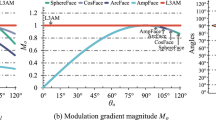Abstract
Pose variation is considered as one of the major challenges that degrade the performance of face recognition systems. Existing techniques address this problem from different attitudes. However, these methods may be inefficient or impractical in the case of single sample face recognition. This article presents an automatic patch-based pose invariant feature extraction method that can handle pose variations for the aforementioned case. The proposed method extracts Gabor and histograms of oriented gradients features from landmark-based patches. The features are then concatenated, dimensionally reduced using principal component analysis, fused using canonical correlation analysis, and normalized using min-max normalization. Experimental results carried out on the FERET database have shown the outstanding performance of the proposed method compared to that of the state-of-the-art approaches. The proposed approach achieved \(100\%\) and \(96\%\) and \(94.5\%\) recognition rates for moderate and wide pose variations, respectively.


Similar content being viewed by others
References
Tan X, Chen S, Zhou Z-H, Zhang F (2006) Face recognition from a single image per person: a survey. Pattern Recognit 39(9):1725–1745
Ding C, Tao D (2016) A comprehensive survey on pose-invariant face recognition. ACM Transactions on intelligent systems and technology (TIST) 7(3):37
Zhang X, Gao Y (2009) Face recognition across pose: a review. Pattern Recognit 42(11):2876–2896
Wang H, Jiani H, Deng W (2017) Face feature extraction: a complete review. IEEE Access 6:6001–6039
Zhou L-F, Yue-Wei D, Li W-S, Mi J-X, Luan X (2018) Pose-robust face recognition with Huffman-LBP enhanced by divide-and-rule strategy. Pattern Recognit 78:43–55
Huang K-K, Dai D-Q, Ren C-X, Yu-Feng Y, Lai Z-R (2017a) Fusing landmark-based features at kernel level for face recognition. Pattern Recognit 63:406–415
Gao Y, Lee HJ (2017) Pose-invariant features and personalized correspondence learning for face recognition. Neural Comput Appl 31:607–616
Duan X, Tan Z-H (2018) A spatial self-similarity based feature learning method for face recognition under varying poses. Pattern Recognit Lett 111:109–116
Shao M, Zhang Y, Yun F (2018) Collaborative random faces-guided encoders for pose-invariant face representation learning. IEEE Trans Neural Netw Learn Syst 29(4):1019–1032
Ding C, Tao D (2015) Robust face recognition via multimodal deep face representation. IEEE Trans Multimed 17(11):2049–2058
Guo Y, Ding X, Xue J-H (2015) Milda: a graph embedding approach to multi-view face recognition. Neurocomputing 151:1255–1261
Cai X, Wang C, Xiao B, Chen X, Zhou J (2013) Regularized latent least square regression for cross pose face recognition. In: Twenty-third international joint conference on artificial intelligence
Wang W, Cui Z, Chang H, Shan S, Chen X (2014) Deeply coupled auto-encoder networks for cross-view classification. arXiv preprint arXiv:1402.2031
Sagonas C, Panagakis Y, Zafeiriou S, Pantic M (2017) Robust statistical frontalization of human and animal faces. Int J Comput Vis 122(2):270–291
Haghighat M, Abdel-Mottaleb M, Alhalabi W (2016) Fully automatic face normalization and single sample face recognition in unconstrained environments. Expert Syst Appl 47:23–34
Gao H, Ekenel HK, Stiefelhagen R (2015) Combining view-based pose normalization and feature transform for cross-pose face recognition. In: 2015 international conference on biometrics (ICB). IEEE, pp 487–492
Ding C, Tao D (2017) Pose-invariant face recognition with homography-based normalization. Pattern Recognit 66:144–152
Deng W, Jiani H, Zhongjun W, Guo J (2017) Lighting-aware face frontalization for unconstrained face recognition. Pattern Recognit 68:260–271
Zhang Y, Qian J, Yang J (2016) Robust face frontalization in unconstrained images. In: Chinese conference on pattern recognition. Springer, pp 225–233
Huang R, Zhang S, Li T, He R (2017) Beyond face rotation: global and local perception GAN for photorealistic and identity preserving frontal view synthesis. In: IEEE international conference on computer vision (ICCV). IEEE, pp 2458–2467
Kan M, Shan S, Chang H, Chen X (2014) Stacked progressive auto-encoders (SPAE) for face recognition across poses. In: Proceedings of the IEEE conference on computer vision and pattern recognition. IEEE, pp 1883–1890
Tran L, Yin X, Liu X (2018) Representation learning by rotating your faces. IEEE Trans Pattern Anal Mach Intell 41:3007–3021
Peng X, Yu X, Sohn K, Metaxas DN, Chandraker M (2017) Reconstruction-based disentanglement for pose-invariant face recognition. In: Proceedings of the IEEE international conference on computer vision, pp 1623–1632
Ding C, Chang X, Tao D (2015) Multi-task pose-invariant face recognition. IEEE Trans Image Process 24(3):980–993
Baltrusaitis T, Robinson P, Morency LP (2013) Constrained local neural fields for robust facial landmark detection in the wild. In: Proceedings of the IEEE international conference on computer vision workshops, pp 354–361
Štruc V, Pavešić N (2010) The complete gabor-fisher classifier for robust face recognition. EURASIP J Adv Signal Process 2010(1):847680
Liu C, Wechsler H (2002) Gabor feature based classification using the enhanced Fisher linear discriminant model for face recognition. IEEE Trans Image process 11(4):467–476
Navneet Dalal, Bill Triggs (2005) Histograms of oriented gradients for human detection. In: IEEE computer society conference on computer vision and pattern recognition, 2005. CVPR 2005, volume 1. IEEE, pp 886–893
Zhang Y, Li H-G, Wang Q, Peng C (2019) A filter-based bare-bone particle swarm optimization algorithm for unsupervised feature selection. Appl Intell 49(8):2889–2898
Zhang Y, Gong D, Gao X, Tian T, Sun X (2020) Binary differential evolution with self-learning for multi-objective feature selection. Inf Sci 507:67–85
Zhang Y, Song X, Gong D (2017) A return-cost-based binary firefly algorithm for feature selection. Inf Sci 418:561–574
Turk M, Pentland A (1991) Eigenfaces for recognition. J Cogn Neurosci 3(1):71–86
Sun Q-S, Zeng S-G, Liu Y, Heng P-A, Xia D-S (2005) A new method of feature fusion and its application in image recognition. Pattern Recognit 38(12):2437–2448
Phillips PJ, Moon H, Rizvi SA, Rauss PJ (2000) The FERET evaluation methodology for face-recognition algorithms. IEEE Trans Pattern Anal Mach Intell 22(10):1090–1104
Author information
Authors and Affiliations
Corresponding author
Ethics declarations
Conflict of interest
The authors declare that there is no conflict of interest.
Additional information
Publisher's Note
Springer Nature remains neutral with regard to jurisdictional claims in published maps and institutional affiliations.
Rights and permissions
About this article
Cite this article
Al-Obaydy, W.N.I., Fadhil, Z.M. & Ali, B.H. Patch-based pose invariant features for single sample face recognition. Evol. Intel. 15, 585–591 (2022). https://doi.org/10.1007/s12065-020-00531-4
Received:
Revised:
Accepted:
Published:
Issue Date:
DOI: https://doi.org/10.1007/s12065-020-00531-4




